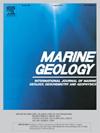Spatiotemporal variability of suspended sediment concentration in the coastal waters of Yellow River Delta: Driving mechanism and geomorphic implications
Abstract
Satellite images have revealed a significant decline in the suspended sediment concentration (SSC) near surface in the coastal waters of Yellow River Delta (YRD) in recent years. However, there is limited information on the spatial disparity in SSC distributions and its dynamic mechanism. In this study, we utilize a well-calibrated SSC retrieval algorithm and a depth-averaged numerical modeling approach to investigate the delta and sub-delta scale variation trends and driving mechanisms of SSC in the coastal waters of YRD over the past few decades. The results of this study demonstrate the existence of high turbidity zones in coastal waters of the northern abandoned delta and the active lobe of the YRD. These zones have experienced general decreasing trends of SSC at the interannual timescale. Additionally, the distribution of SSC is significantly higher in dry seasons compared to that in wet seasons. The magnitude and varying trends of SSC are strongly influenced by the total bottom shear stress (BSS) caused by combined effects of waves and currents, although the wave-induced BSS is found to be less significant that the current-induced one, but vary more significantly due to wind forcing in the Bohai Sea. Furthermore, the grain size of seabed sediments plays a dominant role in the sediment mobilization and resuspension processes over interannual and longer timescales. The distribution of high BSS and sediment mobility zones align with the active areas for morphological changes with the YRD exhibiting net accretion in the active river mouth and erosion in the abandoned delta lobes. These findings highlight the multiscale variations and the close relationship between SSC and BSS, providing valuable insights into sediment dynamics with geomorphic evolution in highly human-interfered deltaic systems.

 求助内容:
求助内容: 应助结果提醒方式:
应助结果提醒方式:


